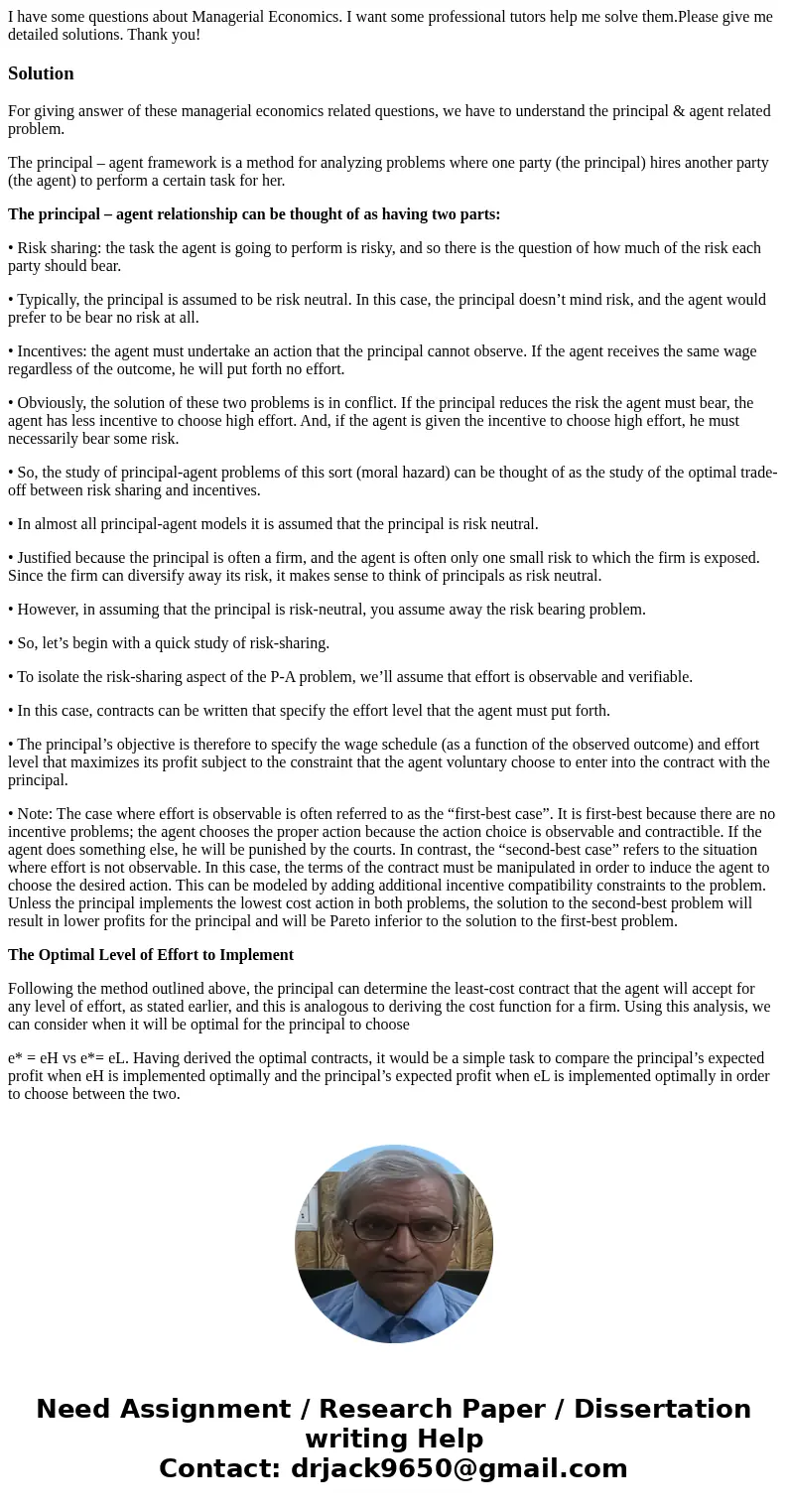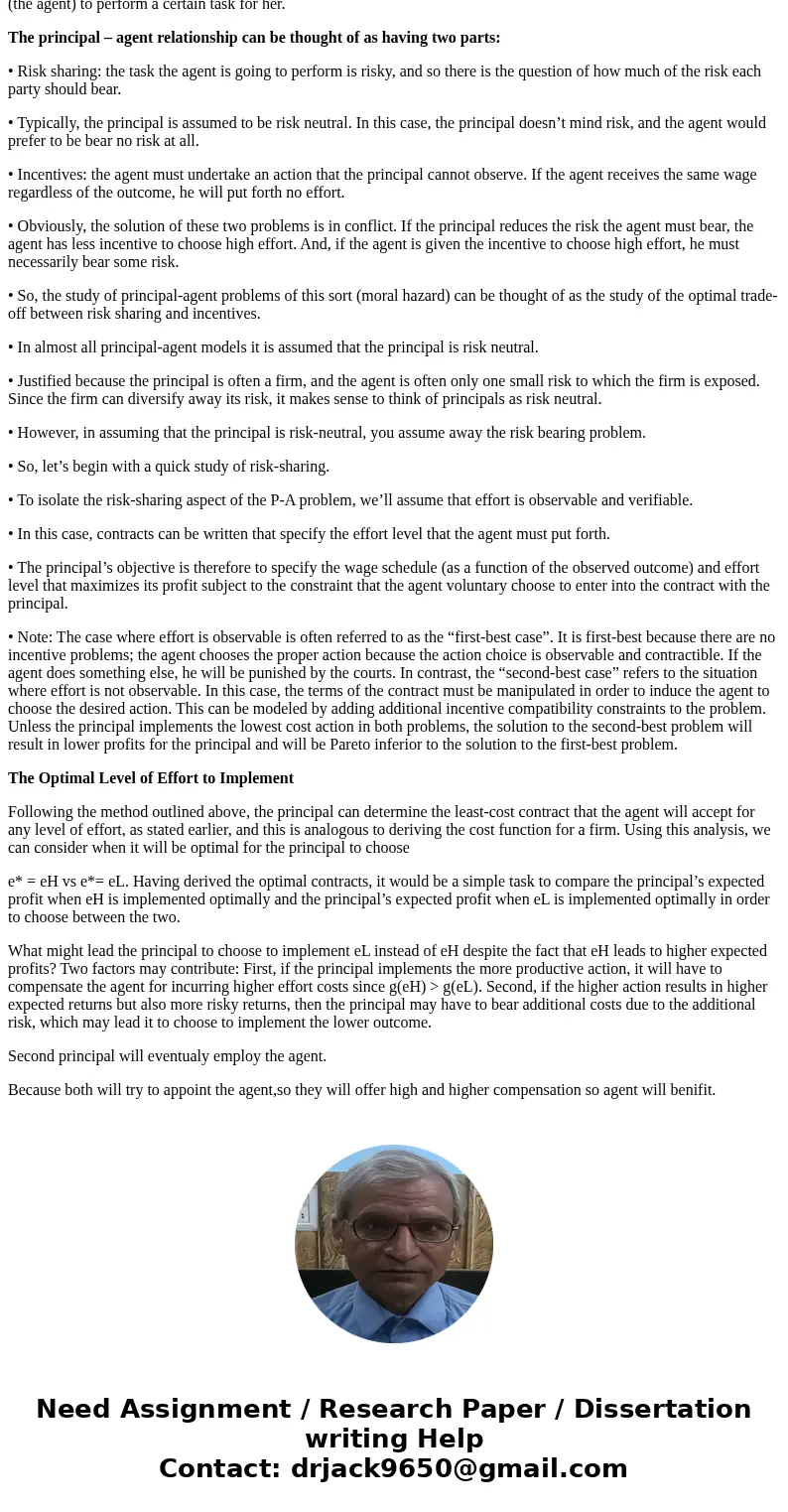I have some questions about Managerial Economics I want some
I have some questions about Managerial Economics. I want some professional tutors help me solve them.Please give me detailed solutions. Thank you!
Solution
For giving answer of these managerial economics related questions, we have to understand the principal & agent related problem.
The principal – agent framework is a method for analyzing problems where one party (the principal) hires another party (the agent) to perform a certain task for her.
The principal – agent relationship can be thought of as having two parts:
• Risk sharing: the task the agent is going to perform is risky, and so there is the question of how much of the risk each party should bear.
• Typically, the principal is assumed to be risk neutral. In this case, the principal doesn’t mind risk, and the agent would prefer to be bear no risk at all.
• Incentives: the agent must undertake an action that the principal cannot observe. If the agent receives the same wage regardless of the outcome, he will put forth no effort.
• Obviously, the solution of these two problems is in conflict. If the principal reduces the risk the agent must bear, the agent has less incentive to choose high effort. And, if the agent is given the incentive to choose high effort, he must necessarily bear some risk.
• So, the study of principal-agent problems of this sort (moral hazard) can be thought of as the study of the optimal trade-off between risk sharing and incentives.
• In almost all principal-agent models it is assumed that the principal is risk neutral.
• Justified because the principal is often a firm, and the agent is often only one small risk to which the firm is exposed. Since the firm can diversify away its risk, it makes sense to think of principals as risk neutral.
• However, in assuming that the principal is risk-neutral, you assume away the risk bearing problem.
• So, let’s begin with a quick study of risk-sharing.
• To isolate the risk-sharing aspect of the P-A problem, we’ll assume that effort is observable and verifiable.
• In this case, contracts can be written that specify the effort level that the agent must put forth.
• The principal’s objective is therefore to specify the wage schedule (as a function of the observed outcome) and effort level that maximizes its profit subject to the constraint that the agent voluntary choose to enter into the contract with the principal.
• Note: The case where effort is observable is often referred to as the “first-best case”. It is first-best because there are no incentive problems; the agent chooses the proper action because the action choice is observable and contractible. If the agent does something else, he will be punished by the courts. In contrast, the “second-best case” refers to the situation where effort is not observable. In this case, the terms of the contract must be manipulated in order to induce the agent to choose the desired action. This can be modeled by adding additional incentive compatibility constraints to the problem. Unless the principal implements the lowest cost action in both problems, the solution to the second-best problem will result in lower profits for the principal and will be Pareto inferior to the solution to the first-best problem.
The Optimal Level of Effort to Implement
Following the method outlined above, the principal can determine the least-cost contract that the agent will accept for any level of effort, as stated earlier, and this is analogous to deriving the cost function for a firm. Using this analysis, we can consider when it will be optimal for the principal to choose
e* = eH vs e*= eL. Having derived the optimal contracts, it would be a simple task to compare the principal’s expected profit when eH is implemented optimally and the principal’s expected profit when eL is implemented optimally in order to choose between the two.
What might lead the principal to choose to implement eL instead of eH despite the fact that eH leads to higher expected profits? Two factors may contribute: First, if the principal implements the more productive action, it will have to compensate the agent for incurring higher effort costs since g(eH) > g(eL). Second, if the higher action results in higher expected returns but also more risky returns, then the principal may have to bear additional costs due to the additional risk, which may lead it to choose to implement the lower outcome.
Second principal will eventualy employ the agent.
Because both will try to appoint the agent,so they will offer high and higher compensation so agent will benifit.


 Homework Sourse
Homework Sourse